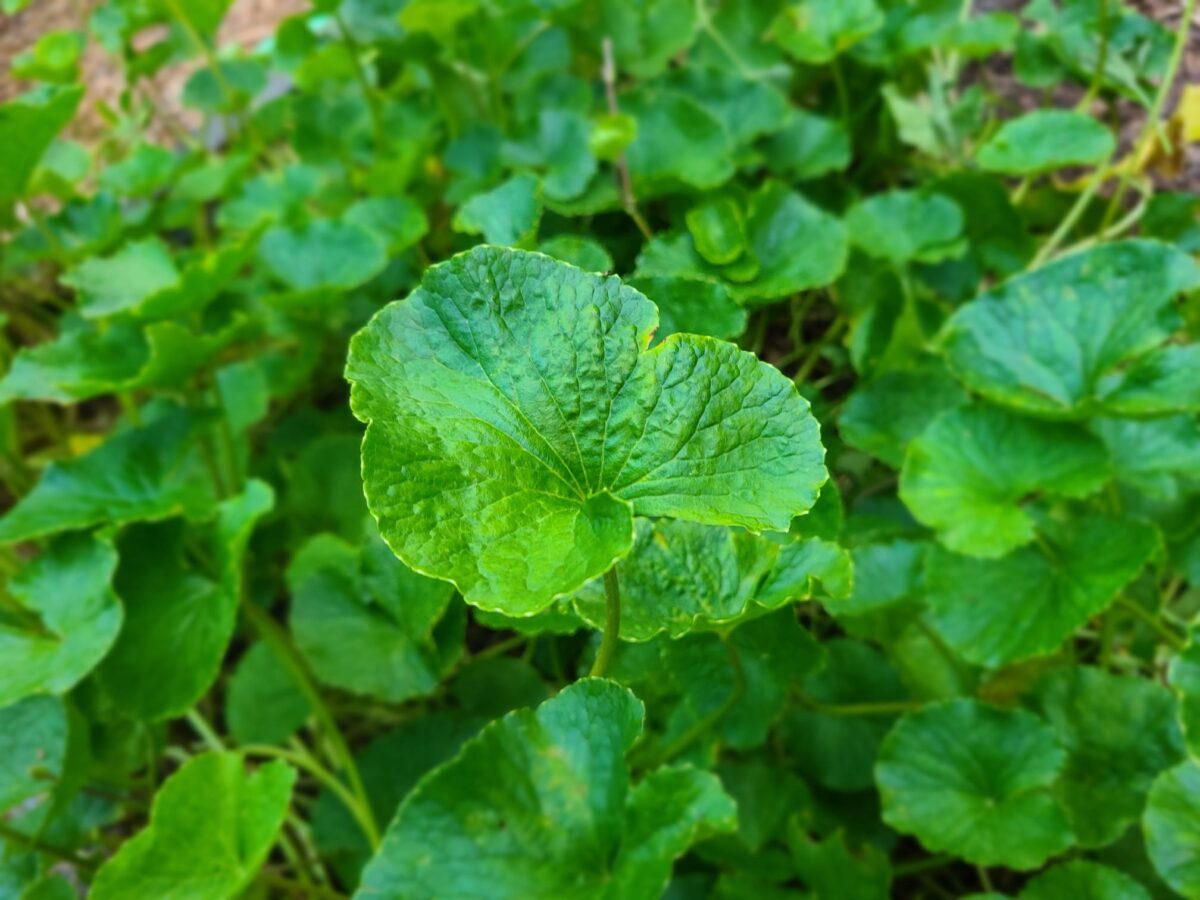Scientific name: Centella asiatica
Other common names: Spadeleaf, Asiatic pennywort, Indian pennywort, 积雪草/ji xue cao (Chinese), hierba de clavo, sombrerito (Spanish), mandukaparni (Sanskrit-meaning frog-leafed), talepetrako, thankuni, and sometimes Brahmi. Brahmi is more commonly the name for the plant Bacopa monnieri Linn.
Hin-Gotu Kola is the Sri Lankan Singhalese name for Centella asiatica and it means cup-shaped leaf.1 Sri Lankan’s are said to have started using the herb after observing elephants eating it and drawing the conclusion that it must contribute to their long lifespans.2 Not wrong in their thinking, a Chinese herbalist named Li Ching-Yun is rumored to have lived until the age of 197 by eating it regularly and the herb appears in the Chinese Shennong Herbal (circa 1st-2nd century CE).3
Identification
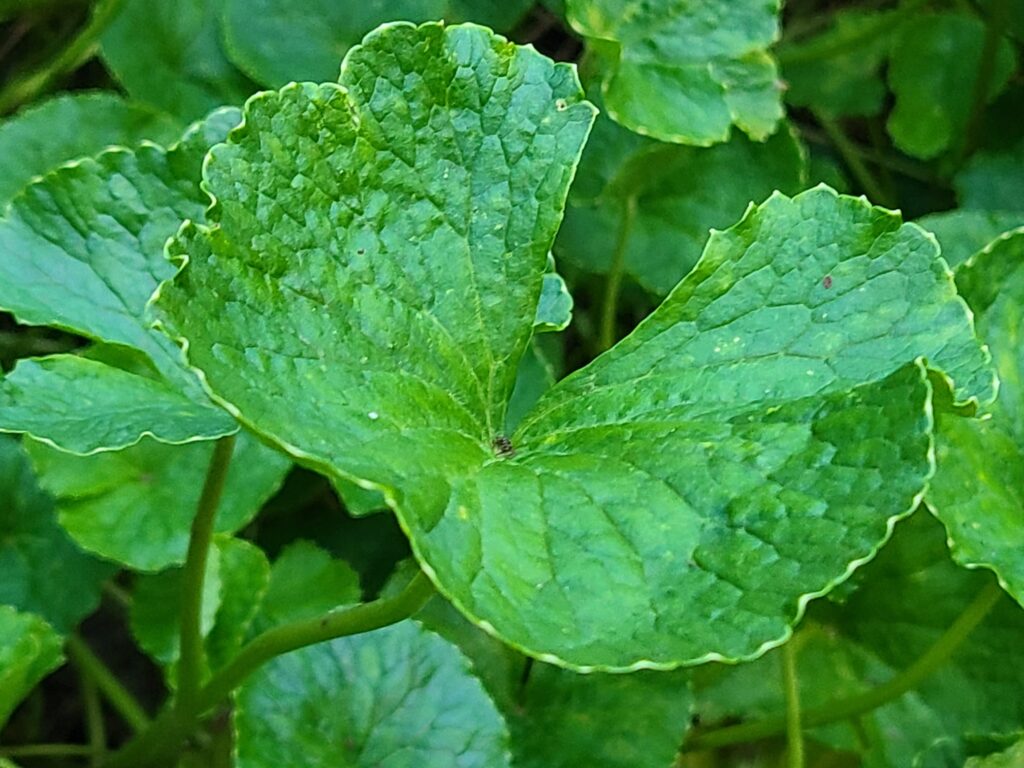
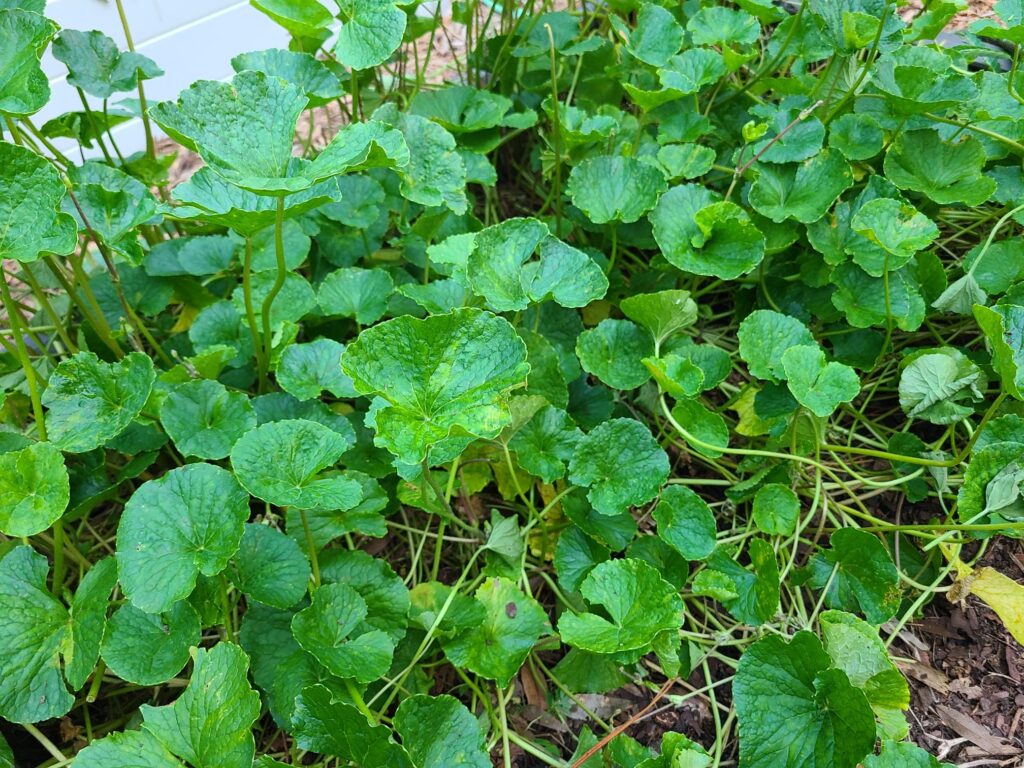
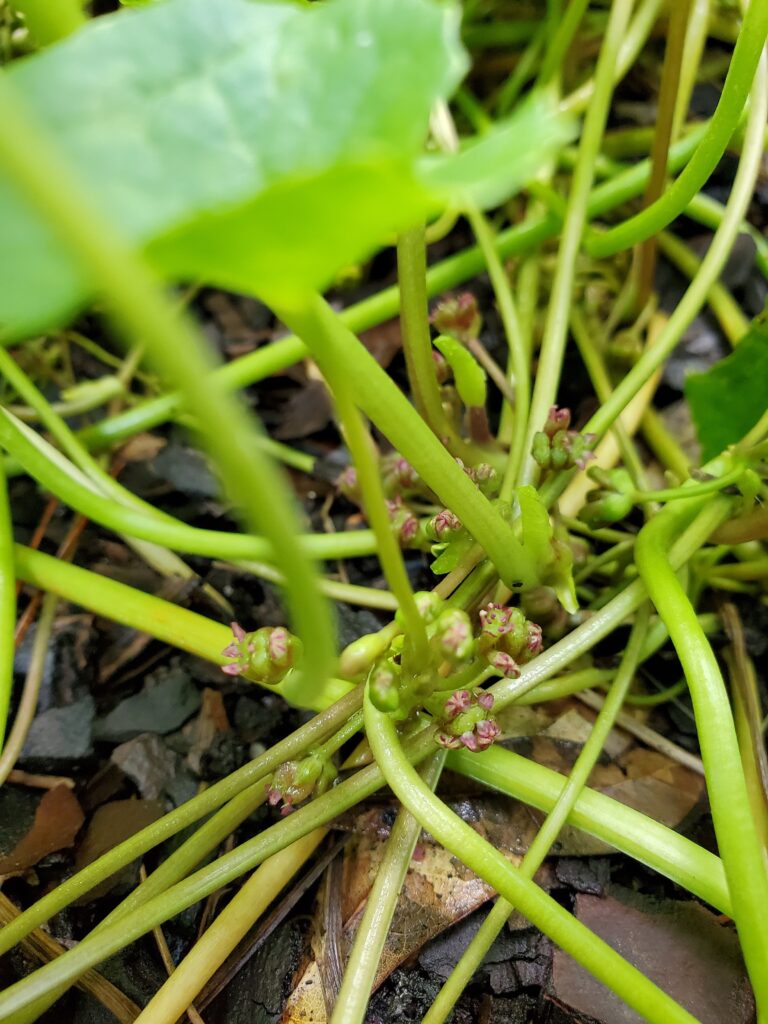
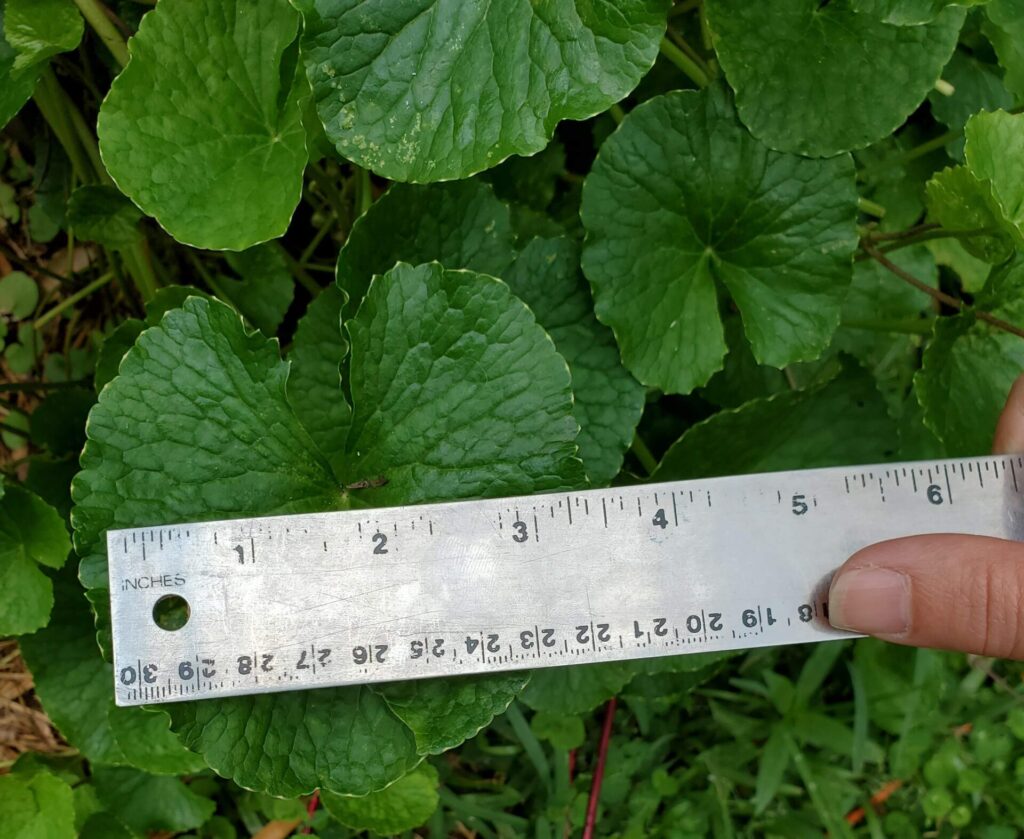
Gotu kola is an aquatic plant meaning that it grows best in temperate, tropical, wet, and swampy areas. It is a ground creeping plant with leaf stalks that can grow quite tall and leaves that are coin-shaped but can grow to be large and have wavy or serrated edges. The leaves are also described as being kidney bean-shaped or fan-shaped. The leaves are generally about 1-5 inch wide and the veins on each leaf extend outward from a center point located at the bottom of the leaf’s split edge.4 The flowers are generally white or pink-red (crimson) in color, in small, rounded bunches (umbels) near the surface of the soil. Flowers are very small, less than 3 mm (0.12 in). Some of these bunches go on to form seeds that can be collected to start new plants. Gotu kola is often mistaken for dollar weed and other pennyworts such as largeleaf pennywort (Hydrocotyle bonariensis) often found at beaches.
Growing/Foraging
This plant is quick to propagate as it roots fairly easily and also spreads through rhizomes (underground tubers). Seeds are also produced by the plant. Planting root sections from the parent is the easiest way to propagate. Plants from root sections are genetically identical to the original plant, whereas planting from seed will give you a genetically different plant. Gotu kola prefers wet conditions but can also grow in drier areas with regular watering. It is considered native to Florida.56
Sustainability
Although considered native, this plant can quickly become invasive due to Florida’s humid climate and frequent rain. It is recommended that it is grown in containment and harvested frequently. In North Florida, you will have to overwinter the plant by covering it with something like straw or pine needles. It is also wise to keep a couple of cuttings indoors in case there is a particularly hard freeze.
Medicinal and Food Properties
Gotu Kola has a history of use as a treatment for cognitive function (such as improving memory, alertness, and mood), syphilis, hepatitis, stomach ulcers, mental fatigue, epilepsy, diarrhea, fever, asthma, dermatological (related to skin), and vascular (related to blood vessel and blood circulation) applications.
A cold process, glycerin extract is recommended for this plant for medicine making. There is concern that heat can impact its qualities.
A number of neurobehavioral effects (meaning it impacts the way the brain affects emotion, behavior, and learning) have been studied for gotu kola, especially for cognitive decline due to both normal aging and disease-related deterioration. Aqueous extracts of C. asiatica seem particularly effective at improving cognitive performance in animal studies.7 While the reasons gotu kola is helpful are not yet well understood, it is theorized that it helps regenerate dendrites, a part of brain cells (called neurons) that communicate with other neurons, through a process called arborization. This word comes from the Latin “arbor” meaning tree because dendrites have a root-like structure that reaches out to the dendrites of other brain cells to make the process of communication via gaps, called synapses, easier. While more robust human studies are needed, the few studies available seem consistent with cognitive improvement.8
Want to know more about its possible cognitive benefits?
This plant can be especially helpful for treating Alzheimer’s and Parkinson’s diseases due to its anti-inflammatory properties, as well as its antiaging/antioxidative and mitochondrial function qualities. Both diseases are characterized by brain inflammation that leads to degeneration/deterioration. The process of aging naturally causes oxidative stress that leads to imbalance and dysfunction of the mitochondrial process. The mitochondrial process is responsible for energy production for cells as well as cell respiration.9 This is also of benefit to stroke survivors, as gotu kola can improve cognitive function after a stroke
Gotu kola has a few skin-related benefits. The powdered herb can be mixed with water or sesame oil and applied externally for eczema, psoriasis, and other skin conditions.10 It has also been reported to help skin circulation and there is some research about its benefits for diabetes-induced skin issues and nerve damage, called neuropathy. Last, it can be used to speed the healing of wounds as well as the appearance of scars, wrinkles, and varicose veins. The current body of evidence suggests that a type of triterpene, known as asiaticoside, is able to stimulate collagen production and promote the development of new blood vessels (angiogenesis) at a site of injury.11 This makes the plant of interest to the beauty and cosmetology industry. When combined with Holy Basil (Tulsi) and Amla, it is a wonderful elixir against hair loss.
A 2019 mice study found that gotu kola may improve renal (kidney) injury by inhibiting inflammation.12 Though this study is relatively new, traditional Chinese medicine has used Gotu kola (Centella asiatica) to treat kidney diseases for centuries and that fact is often cited in kidney dysfunction literature.13
Another reported medicinal use of gotu kola is for reproductive health. The plant has been used in India as a contraceptive and animal studies show that certain bioactive compounds in the plant have anti-fertility effects.14 It has also been used to stimulate menstruation when it has stopped unnaturally (a process called amenorrhea that can be the result of nutrition, stress, or other factors). The leaves boiled in water are eaten to treat urinary tract infections, and the unfiltered plant juice was taken for scrofula and syphilis15 Scrofula is a condition in which the bacteria that causes tuberculosis causes symptoms outside the lungs.
Several uses for mental health, most notable anxiety and mood-stabilizing, are also noted. A 2000 study published in the Journal of Clinical Psychopharmacology16 found a significantly reduced startle response in patients treated with gotu kola.
Nutritionally, C. asiatica is an excellent source of essential vitamins and minerals. According to a review in the International Food Research Journal17, 100 grams of fresh gotu kola delivers the following nutrients and meets the following recommended dietary intake (RDI) needs:
- Calcium: 171 milligrams (17% of the RDI)
- Iron: 5.6 milligrams (31% of the RDI)
- Potassium: 391 milligrams (11% of the RDI)
- Vitamin A: 442 micrograms (49% of the RDI)
- Vitamin C: 48.5 milligrams (81% of the RDI)
- Vitamin B2: 0.19 milligrams (9% of the RDI)
- Gotu kola is also a good source of dietary fiber, providing 8 percent of the RDI for women and 5 percent of the RDI for men.18
This spinach-like plant can generally be consumed in large doses of 3-30 grams per day19 and can be taken as an infusion, powder, herbal ghee, decoction, or milk decoction. 20
Safety
As an aquatic plant, Gotu kola is especially sensitive to biological and chemical pollutants in the water, which may be absorbed into the plant. It is hard to know the conditions in which the plant was grown if you are purchasing online or from abroad.21
Gotu kola can increase sensitivity to the sun for some.
If you’re trying to become pregnant, avoid the plant as it has some contraceptive qualities.
The plant’s effect on pregnancy has not been studied and as such, it may be best to avoid its internal use during the first trimester and limit it during breastfeeding.
Gotu kola is metabolized by the liver. If you have liver disease, it is best to avoid gotu kola supplements to prevent further injury or damage. Long-term use may also induce liver toxicity.22
Gotu kola’s calming effect may be amplified when taking sedatives or alcohol. Avoid taking gotu kola with Ambien (zolpidem), Ativan (lorazepam), Donnatal (phenobarbital), Klonopin (clonazepam), or other sedatives as this can lead to extreme drowsiness.
Recipes
Our Recipes
-
Quick Curry Gotu Kola Salad
A quick summer gotu kola salad that uses simple ingredients.
Other Recipes
Making Organic Gotu Kola Hydrosol
Making Glycerite Extracts
Gotu kola Sambol recipe
Porridge – Gotu Kola Kanda (Herbal gruel) Recipe – Back to Nature
Salad – How to make Emily Dobbs’ Sri Lankan gotu kola dish
Salad & Chutney – Gotukola | A Taste of Sri Lankan cuisine
Chutney – Centella Asiatica Chutney – Naga Style / Fermented Dry Fish Chutney / Gotu Kola Chutney
Sources

